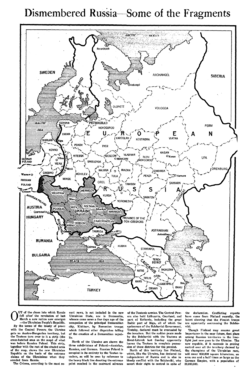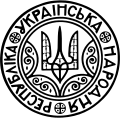جمهورية أوكرانيا الشعبية
Ukrainian People's Republic
| |
|---|---|
| 1917–1918 1918–1920[أ] | |
Coat of arms
(1918–1920) | |
![Article from The New York Times showing the provisional boundaries of the Ukrainian People's Republic emerged from the collapsed Russian Empire in 1918.[1]](/w/images/thumb/e/ec/Dismembered_Russia_%E2%80%94_Some_Fragments_%28NYT_article%2C_Feb._17%2C_1918%29_cropped_map.png/350px-Dismembered_Russia_%E2%80%94_Some_Fragments_%28NYT_article%2C_Feb._17%2C_1918%29_cropped_map.png) Article from The New York Times showing the provisional boundaries of the Ukrainian People's Republic emerged from the collapsed Russian Empire in 1918.[1] | |
| الوضع | Autonomy within the Russian Republic (1917–1918) Partially-recognized state (1918–1920) Government-in-exile (1920–1992) |
| العاصمة | Kiev |
| اللغات المشتركة | Official: Ukrainian Widespread: Russian Minority languages: Yiddish, Polish, German, Belarusian, Romanian, Bulgarian, Greek, Urum, etc. |
| الدين |
|
| صفة المواطن | Ukrainian |
| الحكومة | Republic |
• 1917–1918 | Mykhailo Hrushevskyi |
• 1918–1920[ب] | Directorate |
| President-in-exile | |
• 1926–1954 | Andriy Livytskyi |
• 1954–1965 | Stepan Vytvytskyi |
• 1965–1989 | Mykola Livytskyi |
• 1989–1992 | Mykola Plaviuk |
| التشريع | Central Rada (to April 1918) Labor Congress |
| الحقبة التاريخية | World War I |
• Autonomy declared | 23 June 1917 |
• Republic proclaimed | 20 November 1917 |
• Independence | 22 January 1918 |
• Directorate formed | 13 November 1918 |
• Hetmanate defeated | 14 December 1918 |
• Unity Act signed | 22 January 1919 |
| 18 March 1921 | |
• Authority handed over to post-Soviet Ukraine | 15 March 1992 |
| العملة | Karbovanets Hryvnia |
جزء من سلسلة عن |
|---|
| تاريخ أوكرانيا |
 |
جمهورية أوكرانيا الشعبية (UPR)، أو جمهورية أوكرانيا الوطنية (UNR),[ت] was a country in Eastern Europe that existed between 1917 and 1920. It was declared following the February Revolution in Russia by the First Universal. In March 1917, the National Congress in Kyiv elected the Central Council composed of socialist parties on the same principles as throughout the rest of the Russian Republic. The republic's autonomy was recognized by the Russian Provisional Government. Following the October Revolution, it proclaimed its independence from the Russian Republic on 22 January 1918 by the Fourth Universal.
During its short existence, the republic went through several political transformations – from the socialist-leaning republic headed by the Central Council of Ukraine with its general secretariat to the socialist republic led by the Directorate and by Symon Petliura. Between April and December 1918, the socialist authority of the Ukrainian People's Republic was suspended, having been overthrown by the pro-German Ukrainian State of Pavlo Skoropadskyi, who was elected as a Hetman by a congress of peasants.[2][3][need quotation to verify] From late 1919, the UNR operated as an ally of the Second Polish Republic. On 10 November 1920, the state lost the remainder of its territory to the Bolsheviks. The 18 March 1921 Peace of Riga between the Second Polish Republic, Soviet Russia (acting also on behalf of Soviet Belarus), and Soviet Ukraine sealed the fate of the Ukrainian People's Republic.
After the October Revolution, many governments formed in Ukraine, most notably the Ukrainian People's Republic of Soviets (1917–1918) based in Kharkiv, and its Soviet successors. This force, along with the Ukrainian Republic (based in Kyiv), plus the White Movement, Poland, Green armies, and the Anarchists, fought constantly with each other, which resulted in many casualties among Ukrainians fighting in a 1917–21 Ukrainian Civil War as part of the wider Russian Civil War of 1917–23. The Russian SFSR would (after the 1921 Treaty of Riga) extend control over what would ultimately become the Ukrainian Soviet Socialist Republic and (in 1922) a founding member of the Soviet Union.[2]
. . . . . . . . . . . . . . . . . . . . . . . . . . . . . . . . . . . . . . . . . . . . . . . . . . . . . . . . . . . . . . . . . . . . . . . . . . . . . . . . . . . . . . . . . . . . . . . . . . . . . . . . . . . . . . . . . . . . . . . . . . . . . . . . . . . . . . . . . . . . . . . . . . . . . . . . . . . . . . . . . . . . . . . .
التاريخ
الموجة الثورية

الديمغرافيا
According to the latest census that was taken 1897, the republic was accounted for over 20 million population in seven former Russian guberniyas, plus three uyezds of the Taurida Governorate that were located on the mainland.
- التركيبة الوطنية (بالآلاف)
- الأوكران – 14,931.5 (73%)
- الروس – 2,146.1 (11%)
- اليهود – 1,871.8 (9%)
- الألمان – 451.3 (2%)
- الپولنديون – 375.9 (2%)
- البلاروس – 208.5 (1%)
- الرومانيون – 185.7 (1%)
- غيرهم – 1%
خرائط
Green indicates UPR-controlled territory, red indicates the Red Army control, light yellow for the White Army control, dark yellow for Germany, blue for Poland, and brown for Romania. Bold black line indicates the borders of modern Ukraine.
انظر أيضاً
- General Secretariat of Ukraine
- West Ukrainian People's Republic
- Ukraine after the Russian Revolution
- History of the Jews in Ukraine#Ukrainian People's Republic
- Ukrainian karbovanets – first Ukrainian official currency
- Belarusian People's Republic
- Universal (act)
- Orange Revolution
- February 2014 Euromaidan clashes
- 2014 Russian military intervention in Ukraine
- 2014 Crimean crisis
- Ukrainian Death Triangle
ملاحظات
- ^ Russian autonomy since 1917. De facto independent since late 1917. Interrupted by the pro-German Ukrainian State in April–December of 1918. De facto lost control of most of its territories during 1920. Officially disestablished after the Riga Peace Treaty of 1921. In exile until 1992.
- ^ In exile in 1925.
- ^ Ukrainian: Українська Народня Республіка, romanized: Ukrayinska Narodnya Respublika, in modern orthography Українська Народна Республіка, romanized: Ukrayinska Narodna Respublika; abbreviated: УНР, romanized: UNR
المراجع
- ^ "Dismembered Russia, some of the fragments". The New York Times. 17 February 1918.
- ^ أ ب Yekelchyk 2007.
- ^ Europa Publications (1999). Eastern Europe and the Commonwealth of Independent States, 1999. Taylor & Francis. p. 849. ISBN 978-1-85743-058-5.
المصادر
- Kubijovyč, Volodymyr (1963). Ukraine: A Concise Encyclopædia Vol. 1. Toronto: University of Toronto Press. ISBN 0-8020-3105-6.
- Magosci, Paul Robert (1996). A History of Ukraine. Toronto: University of Toronto Press. ISBN 0-8020-7820-6.
- Subtelny, Orest (2000). Ukraine: A History (3rd ed.). Toronto: University of Toronto Press. ISBN 0802083900. Retrieved 2021-05-22.
- Talmon, Stefan (1998). Recognition of Governments in International Law. Oxford University Press. ISBN 0-19-826573-5.
- Velychenko, Stephen (2010). State building in revolutionary Ukraine: a comparative study of governments and bureaucrats, 1917-1922. Toronto: University of Toronto Press. ISBN 9781442641327.
- Yekelchyk, Serhy (2007). Ukraine: Birth of a Modern Nation (PDF). Oxford: Oxford University Press. ISBN 978-0-19-530545-6.
وصلات خارجية
- Articles containing أوكرانية-language text
- CS1: Julian–Gregorian uncertainty
- Pages using gadget WikiMiniAtlas
- Short description is different from Wikidata
- Articles with hatnote templates targeting a nonexistent page
- Pages using infobox country or infobox former country with the flag caption or type parameters
- Pages using infobox country or infobox former country with the symbol caption or type parameters
- Portal-inline template with redlinked portals
- Pages with empty portal template
- Wikipedia articles needing factual verification from September 2018
- Coordinates on Wikidata
- Ukrainian People's Republic
- Modern history of Ukraine
- Russian Revolution in Ukraine
- Ukrainian independence movement
- History of Ukraine (1795–1918)
- History of Ukraine (1918–1991)
- Post–Russian Empire states
- Former Slavic countries
- 1910s in Ukraine
- 1920 in Ukraine
- States and territories established in 1917
- 1917 establishments in Ukraine
- 1920 disestablishments in Ukraine
- Russia–Ukraine relations
- Russian-speaking countries and territories
- Former countries of the interwar period
- Former socialist republics
- Former countries



